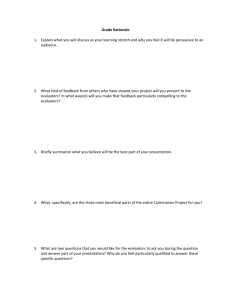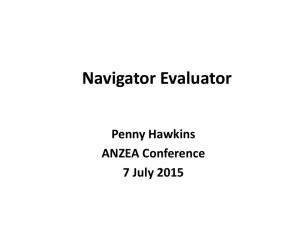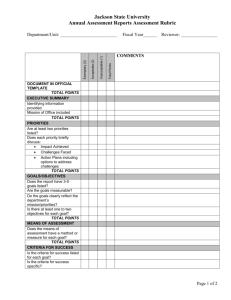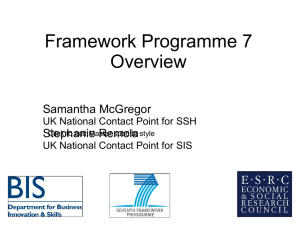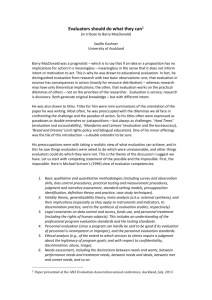2.4ProposalEvaluation
advertisement
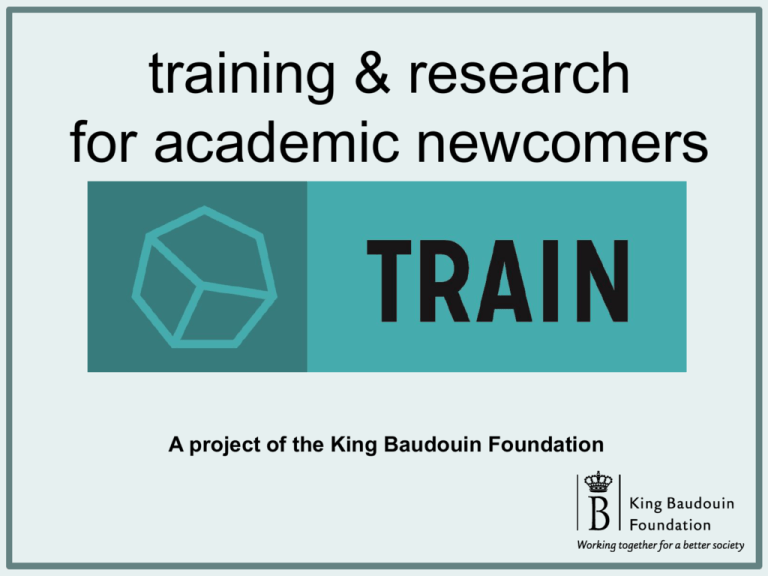
training & research for academic newcomers A project of the King Baudouin Foundation Proposal Evaluation David W Chadwick Three Evaluation Criteria for FP7 1. Scientific and technical quality Soundness of concept and quality of objectives Quality and effectiveness of methodology and associated workplan 2. Implementation Management - Quality of participants and the consortium as a whole Adequacy and Use of the resources 3. Impact Contribution (European or international) to impacts listed in call Appropriateness of measures for dissemination / use Scoring Each criteria is scored out of 5 0- The proposal fails to address the criterion under examination or cannot be judged due to missing or incomplete information 1- Poor. The criterion is addressed in an inadequate manner, or there are serious inherent weaknesses. 2- Fair. While the proposal broadly addresses the criterion, there are significant weaknesses. 3- Good. The proposal addresses the criterion well, although improvements would be necessary. 4- Very Good. The proposal addresses the criterion very well, although certain improvements are still possible. 5- Excellent. The proposal successfully addresses all relevant aspects of the criterion in question. Any shortcomings are minor. Threshold of between 10 to 12 for projects deemed to be fundable Results of FP7 Call 1 Failure: Ineligible Below Threshold Fundable but insufficient funds Success: Retained for negotiation 317 = 14% of total Retained 317 Below Thresholds 1012 Eligible For Funding 884 Evaluation Process - Commission Overview Submission Full/short Proposal Proposal forms Eligibility Individual reading Consensus Panel with optional Hearings Evaluators Evaluators Evaluators Criteria Criteria Criteria Commission Follow-up Final ranking list Rejection list Questions Proposals in suggested priority order Illustration from DG RTD Evaluation Process – Evaluator’s Viewpoint • Does the proposal have a bright idea (or two) • Do the partners complement each other • Does the proposal match the Call Evaluation principles • Transparent – – – – Criteria are laid down in legislation Standardised procedures The process is observed The list of evaluators is made public • (once selection is made, but not who read which proposal!) • Fair – It is the proposal that is judged on its merits – not the proposing organisations – Every proposal is handled the same way whether good or bad • Independent – Commission officials may not intervene in the judgement of the proposal Individual Reading • Similar to reviewing a conference or journal paper • Done remotely in reviewer‘s own time – At home or travelling. Internet access essential for submission of reviewer‘s evaluation report • Strict timetable for completion of reports • Assumed reviewers can evaluate 2 proposals per day • No access to opinion of other evaluators until reviewer‘s own report is completed online • Reviewer‘s scores have to be justified by commenting on the three specific criteria Individual Evaluation Report - Scientific • Scientific and technical excellence – Soundness of objectives and quality of objectives – Progress beyond the state-of-the-art – Quality and effectiveness of the S/T methodology and associated work plan What Will Your Project Achieve Scientifically? A breakthrough – a completely new way of doing things Move a technology closer to widespread adoption Do you have leading researchers? Is the novelty and its benefits clear? What are the chances of success? Do you have appropriate user involvement? Are you integrating existing and novel technologies? Do you have routes to exploitation? Address a need of a specific industrial sector Are the industrial “standard bearers” involved? Do you have a detailed knowledge of the industry? Provide support for the implementation/acceptance of aspects of EU policies or programmes Do you have knowledge of the policies? Are key committees involved? Do you have a track record in policy advice? Bring communities of practitioners together Are you constructing a network? Are the leaders there? Is the network sustainable? Individual Evaluation Report Implementation • Quality and efficiency of the implementation and the management – Appropriateness of the management structure and procedures – Quality and relevant experience of the individual participants – Quality of the consortium as a whole (including complementarity, balance) – Appropriateness of the allocation and justification of the resources to be committed (budget, staff, equipment) Appropriate Management Structure 1 Project Manager EC May be OK for a €3m STREP Not OK for a large €20m IP General Assembly WPm WPm WPm WP2 WP3 WPn Tech Board Appropriate Management Structure 2 Project Manager EC Inappropriate for €3m STREP May be ideal for a €20m IP Quality Manager IP Manager Training Manager General Assembly Dissemination Manager Standardisation Manager Technical Board Technical Manager WPm WPm WPm WP2 WP3 WPn Collaboration Manager Things to Consider • Who’s in the General Assembly? Why? 1 rep. per project partner? Or less? • Is there a need for an external body? If so have they agreed to this? • What about links to other running projects? • Have you spelt out the responsibilities of all the entities in the management structure? • Is there a need for a cross WP management actions? Management Procedures and Processes • Quality Management • Decision Making Procedures – administrative, technical, at WP and project level • • • • Communications Management Project Control Risk Management Interaction with the EC Balancing The Consortium • Show the partner balance clearly • Overlap is not a bad thing, it provides fall-back Partner 1 Skill 1 Partner 3 ……. Partner n X Expertise 1 X Skill 2 Experience 1 Partner 2 X X X X X • Demonstrate skills/ experiences in partner profiles Partner Profiles • Show why you can do what you say you’ll do – History in the field / activity – Publication records – Existing products, R&D, open source • Say who can do it – Provide brief CVs of key people, showing relevant experience – But don’t go overboard • Is the CEO or Vice Chancellor really going to do this? Justifying Person Effort • Is there enough to get the project done? • Is there an over-abundance of time? • Is there an imbalance between WPs? – Can all WPs be done for the stated effort? – Is there an over-supply somewhere? • Is there an imbalance between partners? – Why and is this justified? • Is there an inappropriate academia/ industrial balance? – And are they working on the right WPs? Justifying Travel • Is often a good thing – Plan for it – Explain what you expect to get from it • Think hard about it – What is justifiable? – What consortium meetings can be electronic? • Dissemination and Standardisation – Travel is inevitable – Budget for it Justifying Other Resources • Equipment – Does the project need specialist machines? – Is there a need for mobile demo kit? – What is the re-use value post project • Lease or buy? • Sub contractors – Why are they not in the consortium? – Do they know that they are to be used? Individual Evaluation Report - Impact • Potential impact through the development, dissemination and use of project results – Contribution, at the European and/or international level, to the expected impacts listed in the work programme under relevant topic/activity – Appropriateness of measures for the dissemination and/or exploitation of project results, and management of intellectual property. Who Feels the Impact? Academics Research students Enterprises Suppliers End users Standards groups The EC - can extend their research into new fields and build upon the project’s technical approaches - introduced to new line of science & technology - can enhance products to use technologies developed in the project. - pass on the benefits of project to their end-users - contribute to improved design and functionality of the system via their feedback - Incorporate project’s input to new standards - as the funding agency, tax payers money well spent Impact Should Be Measurable • Otherwise how do know if it has been achieved? • Examples include – – – – – – – – – Website visits, software downloads Articles published Participation in conferences and exhibitions Workshop organisation Patents Demonstrations Licensing agreements Spin out companies New standards • Impact should bring benefits to partners and wider community EC’s Definition of Impact Dissemination • The sharing of project output and results with the wider community in order to build awareness and demand • Show project’s commitment to knowledge sharing • Identify relevant stakeholders and channels to be used to inform them • Example channels: websites, brochures, conferences, newspapers, TV, trade shows etc. Exploitation • Activities that achieve a commercial return or sustainability benefit for the consortium partners from the project results • Brings tangible benefits to partners • Direct – done by partners, Indirect – done by third parties • Potential routes: licensing, open source projects, new partnerships, new project proposals Standards • EU has tradition of supporting standards development • Impacts on wider community, increases competition • Benefits to partners who have a head start on others • Partners should be involved in standard’s creation Other Issues • Say how you will manage the Intellectual Property Rights of both the background and foreground technologies, both during and after the project • Be familiar with concertation meetings of existing related projects • Will you contribute to influencing future work programmes? To Summarise • Is the scientific idea really novel? In what way? What is really exciting about it? • Do the partners appear to have all the skills necessary to achieve their stated objectives? Why should you succeed where others have not? • Are the costs reasonable? • Are the results likely to be usable and will they contribute to Europe’s scientific competitiveness? • Why is it worth the tax payer taking part of the risk? In the words of one seasoned reviewer • Experts are quick to form an opinion – Excellent proposals stand out – Most proposals are good projects, but not excellent ideas • Time is spent verifying or reforming the opinion and justifying the mark – To defend the opinion to other evaluators • The evaluator will not necessarily read the sections in order – Particularly if opening sections are long winded Consensus meeting • Takes place in Brussels with between 3-5 evaulators, possibly an additional rapporteur, a project officer and possibly an observer • Aim is to get a consensus on an agreed score and the justification for it • If a consensus cannot be achieved, additional evaluators will be asked to read the proposal • Discrepancies between hard and soft markers are noted Ranking of Proposals • Ranked according to scores • Where scores are equal, the score of one criteria (usually S&T excellence) will determine its order • All evaluators (except those who may have a conflict of interest) are given the opportunity to comment on the ranking order. • This list goes forward and negotiations are usually started in the order given (though EC may wish to ensure that all topics in a call are covered) Things to Watch Out For • Generic waffle! – Too many words repeating what is stated in the work programmme – Motherhood and apple pie statements • Too much highlighting of buzz words • Lack of clarity on what is to be achieved • Weakly described scenario for ensuring outcomes will be achieved • But – if you dont shout about your strengths then you cannot be credited with them Remember - Horizon 2020 • Starts in January 2014 and takes over from FP7 • So new evaluation mechanisms will be employed • But the material presented here should still be useful Acknowledgements • Thanks to presentations by – Costis Kompis, Vodera Ltd – Tim Courtney – The UK FP7 National Contact Point – Monica Schofield, TuTech Innovation GmbH – The EC • For information and material that has been used in this presentation Any Questions?????? gabriella.calderari@uniroma1.it d.w.chadwick@kent.ac.uk © 2013 Truetrust Ltd 37
